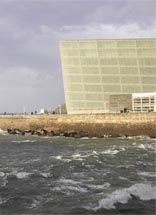
Located 12 miles from the French border, San Sebastián is nestled at the foot of the Pyranees Mountains in the province of Gipuzkoa. The city is well known throughout Spain for its crescent-shaped bay (La Concha) with its beaches and port.
While San Sebastián was quite an ancient city, its history has been far from peaceful. Today, little proof remains of its lengthy heritage. The city was founded around 1180 by King Sancho el Mayor of Navarra and was known as Donostia. Donostia is the Basque term for San Sebastián and is still in wide use today, as is the Basque language, which is spoken by approximately one-third of the city's inhabitants making it one of the more bilingual cities in Spain. From the city's name, the inhabitants also draw the name for themselves donostiarras.
The city began in what is known as the Parte Vieja or Old Quarter, which was walled in for defense. Due to the unique geography of the area, an isthmus joining the city center with Mount Urgull, the bay, the outlet of the Urumea River, and the city's port, it was an ideal military location from early on. For this reason the city was surrounded by a wall and saw many wars and sieges over the ages. In 1813, the city was almost completely destroyed by fire after an explosion caused by Anglo-Portuguese troops barraging the Napoleonic French troops who were occupying the city.

